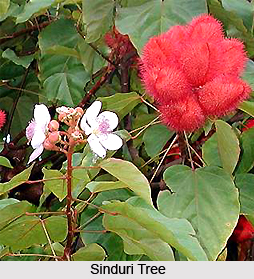 Sinduri is quite common in India and it has the botanical name of Bixa orellana L. Sinduri is the Sanskrit name of the plant and its English names are Annatto or Lipstick Tree. It has many names in different Indian native languages. The Bengali speaking people call the plant as Latkan and Watkan and its Hindi names are Latkan, Lotpan or Senduria. In Gujarati, it is called as Sindhuri and the Marathi speaking people named the plant as Kesari, Sendri and Shendri. While the Tamil people call it as Jafframaram, Japhara or Kurungu-Manjal, the Telugu people know it in the names of Jaffrachettu, Jafra and Japhara.
Sinduri is quite common in India and it has the botanical name of Bixa orellana L. Sinduri is the Sanskrit name of the plant and its English names are Annatto or Lipstick Tree. It has many names in different Indian native languages. The Bengali speaking people call the plant as Latkan and Watkan and its Hindi names are Latkan, Lotpan or Senduria. In Gujarati, it is called as Sindhuri and the Marathi speaking people named the plant as Kesari, Sendri and Shendri. While the Tamil people call it as Jafframaram, Japhara or Kurungu-Manjal, the Telugu people know it in the names of Jaffrachettu, Jafra and Japhara.
Sinduri can be described as a shrub or a small evergreen tree with a height of 2-6 m. The bark of the shrub is brown and more or less smooth. The leaves are glabrous, ovate, having a length of 7-25 cms and width of 4-18 cms with the base sub-cordate and apex acuminate. The leaves are scaly on both surfaces when young, and their petioles are slender, with a length of 4-12 cm.
The pink or white-coloured flowers of the Indian medicinal plant are borne in terminal panicles. Its capsules are red or green in colour, having a length of 3.8 cms and with a shape of ovoid or sub-globose. They are softly prickly and contain approximately 50 trigonous seeds with a red, pulpy covering. The usual flowering season of the plant is between the months of August and September in central India. The plant is a native to tropical America, and has been cultivated and naturalized locally throughout tropical and subtropical India, because of having the red dye that is obtained from the pulp surrounding the seeds (annatto).
Sinduri has a large number of medicinal properties and usages that are useful to the people. The pulp surrounding the seeds of the plant is widely used for medicinal purposes as a haemostatic, anti-dysenteric, diuretic, laxative, febrifuge and digestive. The doctors also prescribe it for treating epilepsy, kidney and some of the skin diseases. The Indian people apply the fresh pulp to burns for preventing blisters and scars. Apart from the pulp, the annatto of the plant is considered as an effective antidote to poisoning by bitter cassava and physic nut. The seeds of this Indian medicinal plant are astringent, febrifuge and people use them to treat gonorrhoea and the seed oil is also reportedly used to treat leprosy.
The Indian people use a decoction of the leaves as a gargle for sore throat, and they also give an infusion of the leaves in cases of jaundice and dysentery. The leaves of Sinduri are a popular febrifuge and are reported to possess anti-tumour properties, as well. A poultice made from the leaves is applied to cuts and gashes as a scar preventative. Apart from that, the pounded leaves release a gummy substance, after being macerated in water and it is commonly diuretic and prescribed in cases of gonorrhoea. While the twigs Sinduri are used to treat liver disorders as an emollient, the root bark is reported to be anti-periodic and is commonly used in the treatment of fevers.



















